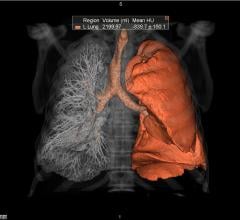If you enjoy this content, please share it with a colleague
RELATED CONTENT
The American Society for Radiation Oncology (ASTRO) is concerned by the Medicare Evidence Development and Coverage Advisory Committee’s (MEDCAC) April 30, 2014 recommendation to the Centers for Medicare and Medicaid Services (CMS) that adults at high risk for lung cancer should not receive Medicare coverage of annual, low-dose computed tomography (LDCT) screening.
The American Society for Radiation Oncology (ASTRO) released a report that recommends critical areas of biological basic research that would most advance the clinical benefits of radiation oncology.
The North Shore-LIJ Health System Department of Radiation Medicine presented a study to evaluate the reliability of different systems used by caregivers to assess toxicity for patients receiving radiation therapy at the 55th Annual Meeting of the American Society of Therapeutic Radiation Oncology (ASTRO).
Patients receiving radiotherapy (RT) for cancers in the pelvic region can experience diarrhea, a negative side effect of radiation treatment. Sulfasalazine, an oral tablet used to treat inflammation of the bowels, had been shown in a past trial of 31 patients to decrease diarrhea during pelvic RT. Sulfasalazine does not reduce diarrhea, according to research presented today at the American Society of Radiation Oncology’s (ASTRO’s) 55th Annual Meeting. The study also determined that the medication might be associated with a higher risk of diarrhea than placebo.
Limiting the amount of radiation absorbed in the hippocampal portion of the brain during whole-brain radiotherapy (WBRT) for brain metastases preserves memory function in patients for up to six months after treatment according to research presented at the American Society for Radiation Oncology’s (ASTRO’s) 55th Annual Meeting.
An analysis of quality of life (QOL) data of stage III lung cancer patients who received higher doses of radiation therapy (with chemotherapy) shows a significantly lower quality of life at 3 months after treatment compared to patients who received a standard dose of radiation (with chemotherapy), according to research presented at the American Society for Radiation Oncology’s (ASTRO’s) 55th Annual Meeting. The study also suggests that lung cancer patients who received intensity modulated radiation therapy (IMRT) reported less decline in their QOL compared to those receiving three-dimensional conformal radiation therapy (3-D CRT).
Proton therapy, an external beam radiotherapy in which protons deliver precise radiation doses to a tumor and spare healthy organs and tissues, is cost-effective in treating medulloblastomas, fast-growing brain tumors that mainly affect children, when compared to standard photon radiation therapy, according to research presented today at the American Society for Radiation Oncology’s (ASTRO’s) 55th Annual Meeting.
The American Society for Radiation Oncology (ASTRO) highlighted the recently published Adjuvant and Salvage Radiotherapy After Prostatectomy: ASTRO/AUA Guideline during ASTRO’s 55th Annual Meeting, September 22-25, 2013, in Atlanta.
CT texture analysis of primary tumors may be a potential imaging biomarker in localized esophageal cancer following neoadjuvant chemotherapy, according to research being presented at the 2013 Cancer Imaging and Radiation Therapy Symposium. This Symposium is sponsored by the American Society for Radiation Oncology (ASTRO) and the Radiological Society of North America (RSNA).


 May 06, 2014
May 06, 2014 



